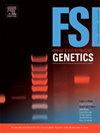模拟案例样本的mRNA分析和供体关联:第三次和第四次EDNAP合作练习的结果
IF 3.1
2区 医学
Q2 GENETICS & HEREDITY
引用次数: 0
摘要
同时识别并将体液与捐赠者联系起来,可以作为混合痕迹刑事调查的有力工具。mRNA靶点的大规模平行测序不仅可以识别体液的来源,还可以利用编码区snp (csnp)提供关于(二元)混合物的体液供体的额外背景信息。在欧洲DNA分析小组(EDNAP)内,组织了两个连续的合作练习(第三次和第四次EDNAP练习),目的是评估两个先前发表的高分辨率mRNA测序测定的性能。在第三次EDNAP练习中,评估BFID-cSNP-BSS测定(血液、唾液和精液的csnp),而在第四次EDNAP练习中,测试BFID-cSNP-6F测定(六种液体/组织的csnp,包括血液、唾液、精液、阴道分泌物、经血和皮肤)。每次RNA cSNP测定都伴随着基因组DNA测定,用于对感兴趣的个体或体液供体的cSNP进行基因分型。共有11个实验室参与了一个或两个合作练习。在每次练习中,参与的实验室收到一套16个标准化的模拟病例染色剂进行分析,并鼓励分析其他自行制备的染色剂和参考样品。实验室可以使用Ion Torrent S5™或Illumina MiSeq™测序系统参与。在这两种练习中,16种模拟病例污渍的结果都非常令人鼓舞,因为可以可靠地识别出大多数污渍的体液成分。由于成功的供体关联取决于测序结果中覆盖的体液标记的数量,我们发现,对于由血液、经血、阴道分泌物或其混合物组成的染色,csnp为成功地将各自的体液与其供体关联提供了大量的遗传歧视性信息。在混合物中,解释cSNP基因型的困难可能归因于存在的其他体液的掩蔽效应。体液鉴定和皮肤样本的供体关联被证明是一个重大挑战。总之,使用BFID-cSNP-BSS和-6 F检测体液鉴定和供体关联是一种有前途和有效的方法,适用于实验室和测序平台。本文章由计算机程序翻译,如有差异,请以英文原文为准。
mRNA profiling and donor association of mock casework samples: Results of a 3rd and 4th EDNAP collaborative exercise
Simultaneous identification and association of body fluids to donors can serve as a powerful tool in the criminal investigation of mixed traces. Massively parallel sequencing of mRNA targets not only identifies the origin of the body fluids but may also provide additional contextual information about the body fluid donors of a (binary) mixture using coding region SNPs (cSNPs). Within the European DNA Profiling Group (EDNAP), two consecutive collaborative exercises (3rd and 4th EDNAP exercise) were organized, with the objective to evaluate the performance of two previously published high-resolution mRNA sequencing assays. In the 3rd EDNAP exercise, the BFID-cSNP-BSS assay (cSNPs for blood, saliva, and semen) was evaluated, while in the 4th EDNAP exercise, the BFID-cSNP-6F assay (cSNPs for six fluids/tissues, including blood, saliva, semen, vaginal secretion, menstrual blood, and skin) was tested. Each RNA cSNP assay was accompanied by a genomic DNA assay for the genotyping of the cSNPs in the individual(s) or body fluid donor(s) of interest. A total of 11 laboratories participated in one or both collaborative exercises. In each exercise, the participating laboratories received a set of 16 standardized mock case stains for analysis and were encouraged to analyze additional, self-prepared stains and reference samples. Laboratories could participate using either the Ion Torrent S5™ or the Illumina MiSeq™ sequencing system. The results of the 16 mock case stains were very encouraging in both exercises, as body fluid components could be reliably identified for most of the stains. Since successful donor association depends on the number of body fluid markers covered in the sequencing results, we found that for stains consisting of blood, menstrual blood, vaginal secretion or a mixture thereof, the cSNPs provided substantial genetic discriminatory information for successful association of the respective body fluid to its donor. In mixtures, the difficulty in interpreting the cSNP genotypes might be attributed to the masking effect of the other body fluid(s) present. Body fluid identification and donor association of skin samples proved to be a significant challenge. In conclusion, body fluid identification and donor association using the BFID-cSNP-BSS and -6 F assays is a promising and effective method across laboratories and sequencing platforms.
求助全文
通过发布文献求助,成功后即可免费获取论文全文。
去求助
来源期刊
CiteScore
7.50
自引率
32.30%
发文量
132
审稿时长
11.3 weeks
期刊介绍:
Forensic Science International: Genetics is the premier journal in the field of Forensic Genetics. This branch of Forensic Science can be defined as the application of genetics to human and non-human material (in the sense of a science with the purpose of studying inherited characteristics for the analysis of inter- and intra-specific variations in populations) for the resolution of legal conflicts.
The scope of the journal includes:
Forensic applications of human polymorphism.
Testing of paternity and other family relationships, immigration cases, typing of biological stains and tissues from criminal casework, identification of human remains by DNA testing methodologies.
Description of human polymorphisms of forensic interest, with special interest in DNA polymorphisms.
Autosomal DNA polymorphisms, mini- and microsatellites (or short tandem repeats, STRs), single nucleotide polymorphisms (SNPs), X and Y chromosome polymorphisms, mtDNA polymorphisms, and any other type of DNA variation with potential forensic applications.
Non-human DNA polymorphisms for crime scene investigation.
Population genetics of human polymorphisms of forensic interest.
Population data, especially from DNA polymorphisms of interest for the solution of forensic problems.
DNA typing methodologies and strategies.
Biostatistical methods in forensic genetics.
Evaluation of DNA evidence in forensic problems (such as paternity or immigration cases, criminal casework, identification), classical and new statistical approaches.
Standards in forensic genetics.
Recommendations of regulatory bodies concerning methods, markers, interpretation or strategies or proposals for procedural or technical standards.
Quality control.
Quality control and quality assurance strategies, proficiency testing for DNA typing methodologies.
Criminal DNA databases.
Technical, legal and statistical issues.
General ethical and legal issues related to forensic genetics.

 求助内容:
求助内容: 应助结果提醒方式:
应助结果提醒方式:


